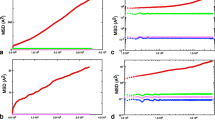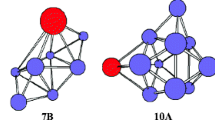Abstract
First principles total energy calculations have been performed to study the hydrogen sulfide (H2S) adsorption on silicane, an unusual one monolayer of Si(111) surface hydrogenated on both sides. The H2S adsorption may take place in dissociative or non-dissociative forms. Silicane has been considered as: (A) non-doped with a hydrogen vacancy, and doped in two main configurations; (B) with an aluminum replacing a hydrogen atom and (C-n; n = 1, 2, 3) with an aluminum replacing a silicon atom at a lattice site. In addition, three supercells; 4x4, 3x3 and 2x2 have been explored for both non-doped and doped silicane. The non-dissociative adsorption takes place in geometries (A), (C-1), (C-2) and (C-3) while the dissociative in (B). Adsorption energies of the dissociative case are larger than those corresponding to the non-dissociated cases. In the dissociative adsorption, the molecule is fragmented in a HS structure and a H atom which are bonded to the aluminum to form a H-S-Al-H structure. The presence of the doping produces some electronic changes as the periodicity varies. Calculations of the total density of states (DOS) indicate that in most cases the energy gap decreases as the periodicity changes from 4x4 to 2x2. The features of the total DOS are explained in terms of the partial DOS. The reported charge density plots explain quite well the chemisorptions and physisorptions of the molecule on silicane in agreement with adsorption energies.





Similar content being viewed by others
References
Çakmak M, Srivastava GP (1998) Ab initio study of atomic geometry, electronic states, and bonding for H2S adsorption on III-V semiconductor (110)-(1 × 1) surfaces. Phys Rev B 57:4486–4492. doi:10.1103/PhysRevB.57.4486
Çakmak M, Srivastava GP (1999) Adsorption of partially and fully dissociated H2S molecules on the Si(001) and Ge(001) surfaces. Phys Rev B 60:5497–5505. doi:10.1103/PhysRevB.60.5497
Russell SM, Liu D-J, Kawai M, Kim Y, Thiel PA (2010) Low-temperature adsorption of H2S on Ag(111). J Chem Phys 133:124705–124713. doi:10.1063/1.3481481
Jayaraman V, Mangamma G, Gnanasekaran T, Periaswami G (1996) Evaluation of BaSnO3 and Ba(Zr,Sn)O3 solid solutions as semiconductor sensor materials. Solid State Ionics 86–88:1111–1114. doi:10.1016/0167-2738(96)00277-9
Akimov BA et al. (1997) The electrical conductivity of polycrystalline SnO2(Cu) films and their sensitivity to hydrogen sulfide. Semiconductors 31:335–339. doi:10.1134/1.1187182
Schutt HU, Rhodes PR (1996) Corrosion in an aqueous hydrogen sulfide, ammonia, and oxygen system. Corrosion 52(12):947–952. doi:10.5006/1.3292088
Conrad S, Mullins DR, Xin QS, Zhu XY (1996) Thermal and photochemical deposition of sulfur on GaAs(100). Appl Surf Sci 107:145–152. doi:10.1016/S0169-4332(96)00499-0
Jiang DE, Carter EA (2005) First principles study of H2S adsorption and dissociation on Fe(110). Surf Sci 583:60–68. doi:10.1016/j.susc.2005.03.023
Ren C, Wang X, Miao Y, Yi L, Jin X, Tan Y (2010) DFT study of the dissociative adsorption of H2S molecule on the Si(1 1 1)-7 × 7 surface. J Mol Struct (THEOCHEM) 949:96–100. doi:10.1016/j.theochem.2010.03.014
Fujiwara K (1981) Electron orbital energies of H2S and H2O chemisorbed on the Si(111) 7 × 7 surface. J Chem Phys 75:5172–5179. doi:10.1063/1.441867
Rezaei MA, Stipe BC, Ho W (1998) Atomically resolved determination of the adsorption sites as a function of temperature and coverage: H2S on Si(111)-(7 × 7). J Phys Chem B 102(52):10941–10947. doi:10.1021/jp983207b
Rezaei MA, Stipe BC, Ho W (1998) Inducing and imaging single molecule dissociation on a semiconductor surface: H2S and D2S on Si(111)-7 × 7. J Chem Phys 109:6075–6078. doi:10.1063/1.477233
Chakarov DV, Ho W (1995) Thermal and photo-induced desorption, dissociation, reactions of H2S adsorbed on Si(111) 7 × 7. Surf Sci 323:57–70. doi:10.1016/0039-6028(94)00661-X
Novoselov KS et al. (2005) Two-dimensional atomic crystals. Proc Natl Acad Sci USA 102:10451–10453. doi:10.1073/pnas.0502848102
Novoselov KS et al. (2005) Two-dimensional gas of massless Dirac fermions in graphene. Nature 438:197–200. doi:10.1038/nature04233
Lebégue S, Eriksson O (2009) Electronic structure of two-dimensional crystals from ab initio theory. Phys Rev B 79:115409–115413. doi:10.1103/PhysRevB.79.115409
Hussain T et al. (2011) Ab initio study of lithium-doped graphane for hydrogen storage. EPL 96:27013–27017. doi:10.1209/0295-5075/96/27013
Hussain T, Pathak B, Ramzan M, Maark TA, Ahuja R (2012) Calcium doped graphane as a hydrogen storage material. Appl Phys Lett 100:183902–183907. doi:10.1063/1.4710526
Houssa M, Pourtois G, Afanas’ev VV, Stesmans A (2010) Can silicon behave like graphene? A first-principles study. Appl Phys Lett 97:112106–112109. doi:10.1063/1.3489937
Houssa M, Scalise E, Sankaran K, Pourtois G, Afanas’ev VV, Stesmans A (2011) Electronic properties of hydrogenated silicene and germanene. Appl Phys Lett 98:223107–223110. doi:10.1063/1.3595682
Lew Yan Voon LC, Sandberg E, Aga RS, Farajian AA (2010) Hydrogen compounds of group-IV nanosheets. Appl Phys Lett 97:163114–163117. doi:10.1063/1.3495786
Şahin H, Cahangirov S et al. (2009) Monolayer honeycomb structures of group-IV elements and III-V binary compounds: First-principles calculations. Phys Rev B 80:155453–155465. doi:10.1103/PhysRevB.80.155453
Cahangirov S, Topsakal M, Aktürk E, Şahin H, Ciraci S (2009) Two- and one-dimensional honeycomb structures of silicon and germanium. Phys Rev Lett 102:236804–236808. doi:10.1103/PhysRevLett.102.236804
Wang S (2010) Studies of physical and chemical properties of two-dimensional hexagonal crystals by first-principles calculation. J Phys Soc Jpn 79:064602–064607. doi:10.1143/JPSJ.79.064602
Kara A et al. (2009) Physics of silicene stripes. J Supercond Nov Magn 22:259–263. doi:10.1007/s10948-008-0427-8
Aufray B et al. (2010) Graphene-like silicon nanoribbons on Ag(110): a possible formation of silicene. Appl Phys Lett 96:183102–183105. doi:10.1063/1.3419932
Padova DE, Quaresima C et al. (2011) sp2-like hybridization of silicon valence orbitals in silicene nanoribbons. Appl Phys Lett 98:081909–081912. doi:10.1063/1.3557073
Guzmán-Verri GG, Lew Yan Voon LC (2011) Band structure of hydrogenated Si nanosheets and nanotubes. J Phys Condens Matter 23:145502–145507. doi:10.1088/0953-8984/23/14/145502
Cheng YC, Zhu ZY, Schwingenschlögl U (2011) Doped silicene: evidence of a wide stability range. EPL 95:17005–17010. doi:10.1209/0295-5075/95/17005
Takeda K, Shiraishi K (1989) Electronic structure of Si-skeleton materials. Phys Rev B 39:11028–11037. doi:10.1103/PhysRevB.39.11028
Van de Walle CG, Northrup JE (1993) First-principles investigation of visible light emission from silicon-based materials. Phys Rev Lett 70:1116–1119. doi:10.1103/PhysRevLett.70.1116
Nakano H et al. (2006) Soft synthesis of single-crystal silicon monolayer sheets†. Angew Chem 118(38):6451–6454. doi:10.1002/ange.200600321
Dahn JR, Way BM, Fuller E (1993) Structure of siloxene and layered polysilane (Si6H6). Phys Rev B 48:17872–17877. doi:10.1103/PhysRevB.48.17872
Soler JM, Artacho E, Gale JD (2002) The SIESTA method for ab initio order-N materials simulation. J Phys Condens Matter 14:2745–2779. doi:10.1088/0953-8984/14/11/302
Ordejon P, Artacho E, Soler JM (1996) Self-consistent order-N density-functional calculations for very large systems. Phys Rev B 53:10441–10444. doi:10.1103/PhysRevB.53.R10441
Perdew JP, Burke K, Ernzerhof M (1996) Generalized gradient approximation made simple. Phys Rev Lett 77:3865–3868. doi:10.1103/PhysRevLett.77.3865
Hamann DR, Schlüter M, Chiang C (1979) Norm-conserving pseudopotentials. Phys Rev Lett 43:1494–1497. doi:10.1103/PhysRevLett.43.1494
Bachelet GB, Hamann DR, Schlüter M (1982) Pseudopotentials that work: from H to Pu. Phys Rev B 26:4199–4228. doi:10.1103/PhysRevB.26.4199
Kleinman L, Bylander DM (1982) Efficacious form for model pseudopotentials. Phys Rev Lett 48:1425–1428. doi:10.1103/PhysRevLett.48.1425
Junquera J, Paz Ó, Sánchez-Portal D, Artacho E (2001) Numerical atomic orbitals for linear-scaling calculations. Phys Rev B 64:235111–235120. doi:10.1103/PhysRevB.64.235111
Monkhorst HJ, Pack JD (1976) Special points for Brillouin-zone integrations. Phys Rev B 13:5188–5192. doi:10.1103/PhysRevB.13.5188
Edwards TH, Moncur NK, Snyder LE (1967) Ground–state molecular constants of hydrogen sulfide. J Chem Phys 46:2139–2142. doi:10.1063/1.1841014
Lai Y-H, Yeh C-T, Lin Y-H, Hung W-H (2002) Adsorption and thermal decomposition of H2S on Si(100). Surf Sci 519:150–156. doi:10.1016/S0039-6028(02)02208-2
Dominic RA (2008) First-principles studies of H2S adsorption and dissociation on metal surfaces. Surf Sci 602:2758–2768. doi:10.1016/j.susc.2008.07.001
Jiang DE, Carter EA (2004) Adsorption, diffusion, and dissociation of H2S on Fe(100) from first principles. J Phys Chem B 108:19140–19145. doi:10.1021/jp046475k
Leenaerts O, Partoens B, Peeters FM (2009) Water on graphene: hydrophobicity and dipole moment using density functional theory. Phys Rev B 79:235440. doi:10.1103/PhysRevB.79.235440
Acknowledgments
We wish to acknowledge the partial financial support of projects: Cuerpo Académico Física Computacional de la Materia Condensada (BUAP-CA-194) and VIEP-BUAP-EXC11-G. We are also grateful to the technical assistance of L. Rojas and N. Mendes at the computer center, in the Instituto de Física “Luis Rivera Terrazas” of the Universidad Autónoma de Puebla (IFUAP).
Author information
Authors and Affiliations
Corresponding author
Rights and permissions
About this article
Cite this article
Sánchez-Ochoa, F., Guerrero-Sánchez, J., Canto, G.I. et al. Density functional theory studies of the adsorption of hydrogen sulfide on aluminum doped silicane. J Mol Model 19, 2925–2934 (2013). https://doi.org/10.1007/s00894-013-1873-1
Received:
Accepted:
Published:
Issue Date:
DOI: https://doi.org/10.1007/s00894-013-1873-1




